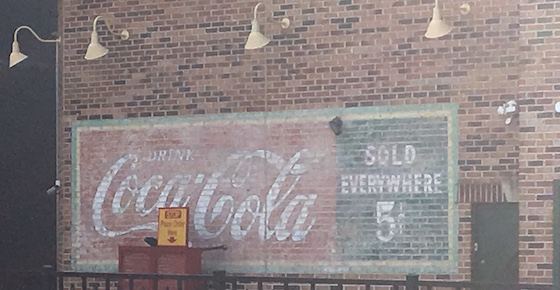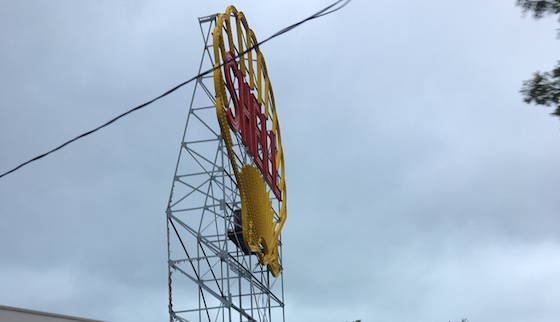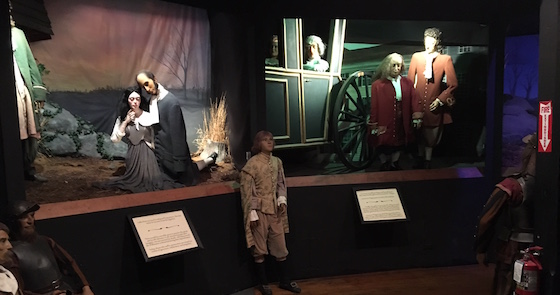Memo From Frank
Americans are bombarded by ad messages. They are all over the internet. Television. Radio. Publications. All those ads have created a problem for advertisers: there are so many messages how can the consumer actually have the curiosity or time to read or listen to any? This is one of the key strengths of billboards – there are not that many ad messages on the open road. The reason? The Highway Beautification Act. This simple act of Congress – passed in the 1960s – controls how many advertisements there can be on the nation’s highways and byways. Prior to this Act, you could place a billboard anywhere you wanted to, with no restrictions. But all that changed with the Highway Beautification Act, which suddenly limited billboards to certain spacing and zonings. It’s an interesting fact that this very piece of legislation, that was designed to put billboards out of business, actually served to create the industry. Without the Beautification Act, there would be no money in billboards, since the supply would be infinite. It just goes to show that politicians don’t always know the actual consequences of what they’ve done until it’s too late. A good moral for this political elections season.
How To Measure The Correct Height For A Sign

This is an actual photo of a sign that is built behind a building. Note that the bottom of the sign is almost perfectly above the top of the roof line. You see signs like this frequently. If the sign was even a foot shorter, the ad would be ruined. So how do you measure how tall to build a sign?
First tip: view only from a car on the road the sign is to be viewed from
All of the following methods are designed to replicate the height of the bottom of the sign – but can only be viewed from a car on the intended road the sign reads to. You cannot simply measure an object, like a tree, and say “I’ll just build the sign 5’ higher than that”. This is because of the law of parallax. Here’s a good example of parallax. Take you thumb and hold it up to you eye. Your thumb is taller than a person in the background because your thumb is closer to your eye than the person. When you measure any object, that’s only part of the equation. With parallax, the shorter object may actually appear larger.
Flagging pole
This is a fiberglass pole that raises in 5 foot sections that you then twist the pole and lock in position. It can extend all the way up to 45’ in the air with some models. This is the most accurate gauge of height, but only when you are able to keep it perfectly straight. In any amount of wind or movement, the pole will sway, which will show a lower height than what’s actually there. That’s why this is our #2 choice, and not the #1.
Crane
This is our #1 choice. Here’s how it works. You hire a skyhook crane (the smallest one there is). You put the crane where the pole of the sign will be. You tie a red flag on to the ball of the crane (where the hook is). You let out the exact amount of cable as the height of the ad face. You then raise the whole unit to the top of the sign’s projected height. This gives you a platform that shows both the top and bottom of the sign, and does not move in the wind. You drive and photograph this, and you have a permanent record that shows exactly what the final sign will look like. This is the professional way to do it. I can assure you what the sign shown at the top of this article was measured in this manner. That’s the only way you can get it that accurate.
Helium balloon
OK, let’s say that you don’t have the $500 to buy a flagging pole, much less the $500 cost of hiring the crane. So what do you do? The dollar store version costs about $10. You buy a large helium balloon and a bunch of string. You measure the string to equal the bottom of the sign. You let go of the balloon and let it rise to that height. You then drive the balloon and see how it looks. This version only works in the complete absence of wind. However, it’s still better than nothing, as you might catch the one moment when the wind is low to see where you stand.
Conclusion
Measuring the height of the sign is vital to avoid obstructions. Those are some ideas to make that happen.
The Unusual Facts About Railroad Leases

The relationship between the railroad and billboards goes back hundreds of years. In fact, many early billboards were designed to be viewed from passengers in trains, since automobiles had not yet been invented. But the real significant tie between billboards and railroads is as lessee and lessor.
Largest single billboard landowner in the U.S.
Most people are unaware that American railroads are the single largest landowner to billboard companies in the U.S. Of these, it is thought that the Southern Pacific line is the largest single landowner for billboards in the United States. This is a significant achievement. As a result, it’s very important that anyone in the industry understand how railroad ground leases typically work.
Unusual right-of-way exceptions
It’s also important to understand the unique attributes of railroads as property owners. One of the most unusual abilities that railroads have is to place billboards where nobody else can. This is because railroads, for the most part, are exempt from zoning and setback regulations. You can see this in many urban markets when the billboard is located in the middle of the road, such as in the photo on the top of this article. Railroads can do that because they are the only group in the U.S. to own property crossing highways and major roads. Nobody else is allowed to do so.
24 hour length
One of the big risks of railroad ground leases for billboards is a standard 24 hour length. That’s right, your lease is only good for one day and, if not cancelled, then renews for another day. As you can imagine, this causes some difficulty when it comes to obtaining bank financing (or even sleeping at night) as there is no guarantee that your sign will last more than a day once you build it. Of course, the reality is that there are signs on railroad property that have been standing for 100 years. But the fact that you don’t really have much control over that can be very disturbing.
Little risk of re-development
One reason that billboard companies can typically accommodate the 24 hour lease issue is that the chance for redevelopment of railroad property is very low. You can’t build an office building on a 20’ wide parcel. And the railroad can’t sell off property unless they shut the whole route down. The future of most American railroad right-of-way is simply: railroad right-of-way.
But lots of risk on railroad right-of-way re-design
Although there is not much risk of railroad property being converted into something else, there is still risk of it being remodeled for railroad use. Trains have changed over time. One big change was when they started to carry stacked metal containers. This height increase required removal of certain billboards that did not have enough clearance above the tracks. Although I’m unaware of any current design changes, if there are any, the railroad would immediately cancel the billboard lease on any sign that does not accommodate that change. They are more concerned about keeping the trains running safely than their billboard leases.
Conclusion
Railroads offer some unique billboard locations, but also some unique challenges. They are America’s biggest landowner to billboard signs, but they are not the dream lessor. You need to be aware of the facts.
Billboard Home Study Course
![]() How to Find a Billboard Location
How to Find a Billboard Location
![]() How to Buy a Billboard
How to Buy a Billboard
![]() How to Build a Billboard
How to Build a Billboard
![]() How to Operate a Billboard
How to Operate a Billboard
![]() How to Rent Ad Space on a Billboard
How to Rent Ad Space on a Billboard
![]() How to Sell a Billboard
How to Sell a Billboard
Get Your Copy Now!
Everything You Need To Know About Wallscapes

The highest producing billboards in the U.S. are wallscapes – those billboards that are mounted directly to walls. The combine high ad revenue and low construction cost, which yields the highest cash-on-cash returns. So what makes wallscapes so special?
Low cost of entry
There is no billboard that is as inexpensive to build as a wallscape on a per-square-foot of ad space basis. You can literally build a massive wall scape for $1,000 to $4,000 in cost. For many people, this low cost of entry is essential to get them started. The only signs with a potentially lower cost of entry are wooden telephone pole signs, and buying abandoned signs.
Largest signs in the U.S.
The biggest billboards in the U.S. are all wallscapes. You’ve probably seen many of them, either while driving through urban markets or on TV. Times Square has quite a few, but Los Angeles is probably the world-record holder. Some of these signs are literally several hundred feet long. Because of their giant size, they rent for giant amounts of money. The only limitation on size are 1) the size of the wall and 2) the maximum under the local sign ordinance.
Strong, urban locations due to easy installation
Most U.S. wallscapes are found in urban locations. That’s simply because that’s where you find most of the large walls. There are few high-rise buildings in small towns. Most of these wallscapes are found right in the heart of downtown. This is because the vinyl installation process allows wallscapes to be placed practically anywhere a building is located, and downtown is the most in-demand spot to place them. Some cities have ordinances that only allow wallscapes in downtown – they think that they actually beautify these areas.
But still possible almost anywhere (based on ordinance)
But wallscapes don’t have to be only in urban areas. Any place that there’s a wall and a legal location are fair game. In fact, where there are few higher buildings, then there is more opportunity to be seen. I know someone who built a giant wallscape on a grain elevator in Colorado. Think about other large landmarks you’ve seen. Remember that the Highway Beautification Act generally only controls signs that are within 550’ of the right-of-way. Farther off and there are no laws. Check your state sign regulations.
Vinyl perfected the business model
But it wasn’t always this easy or profitable to build wallscapes. Prior to the invention of vinyl technology, all signs had to be hand-painted. This meant that wallscapes required heavy, expensive-to-install panels to paint on, as well as incredibly expensive paint jobs that took weeks to complete. And you can’t do photo-quality painting on bricks. So, really, wallscapes only became so attractive to own over the past 20 years or so.
Conclusion
Wallscapes are terrific investments. They offer a giant canvas for advertisers and a low entry price. They are one of the highest-return types of billboards in the U.S.
Subtle Hints Of The Beginnings Of The Industry

Billboards are a part of the American culture. And their history can be found all around you, if you only keep an eye out. Here are some of the priceless pieces of billboard Americana that you can find along any given highway
Old wallscapes
These are hand-painted advertisements on old brick walls. Very common in both urban and rural areas. Coca-Cola signs are the norm (such as the photo shown above) but a variety of products are frequently"
Barn roofs
Mail Pouch Tobacco was the most dominant advertiser on barn roofs, bet even some current advertisers such as Meramec Caverns can be found on these. The concept was to utilize the farmer’s barn roof as an early type of billboard. In exchange, the barn owner typically received a free coat of paint.
Burma Shave
These signs can still be found on many older highways – abandoned but still legible. Burma Shave was a big-time shaving cream from the 1920s to 1960s, before dying out. Their signs are typically several in a row, with each sign having only one word. To get the ad message, you have to read the whole series. These signs are commonly featured in Route 66 museums.
Abandoned structures
You can find many historic ad messages on old, abandoned, wooden billboards. One of my favorites was on a sign that I bought and brought back to life in Dallas. The ad was for “Earl White’s Revue”, which was a big band performing in Dallas in the 1950’s. Often these older messages are visible because the modern ad on the sign falls off over time, and these old messages were hidden under a sheet of plywood.
Conclusion
If you stay alert, you can find a virtual history museum of billboards along any given highway. And some of these old signs can be brought back to life, so there’s a financial incentive to stay alert, too.
New Billboards For Sale On OutdoorBillboard.com
A Primer On Dating Signs Based On Structure Type

While it’s hard to guess someone’s age at the fair midway (and you get a stuffed animal if they fail) it’s not so hard to guess the rough age of a billboard, based on the way that it’s constructed. So how can you do it?
Wooden telephone pole
This first type of sign is a trick question. Wooden telephone billboards were common in the 1920s – and they’re still being built today. So if you see a wooden sign, don’t just assume that it’s been there for a long time. Around my small town in Missouri, they go up all the time. It’s a testament to the design that they are built the same today as they were 100 years ago. The only difference is that modern signs are vinyl wrapped.
Welded angle-iron
These signs (a photo of which is above) are made of an intricate jumble of metal angle iron, completely welded together. This type of sign is the earliest form of metal construction – typically dating from the early 1900s to about 1930. They are extremely labor-intensive to produce and have severe structural problems over time, due to welds breaking and rust.
I-Beam
These signs are marked by huge I-beams (they look like a letter “I” on cross-section) that began in the 1920s. The I-beam was invented during the building boom of the Roaring 20’s, when high rises went up in many cities. Leftover I-beams were used for a number of purposes, one of which was building billboards. While a good product, the I-beam required a great deal of welding in the field to assemble, and was not very aesthetically pleasing. They began to die out with the invention of the monopole in the 1970s.
Monopole
This is the state of the art in metal signs, and started being common in the 1970s. The rolled metal column that holds the sign up was a byproduct of the Alaska Pipeline – it was originally developed to hold oil. The beauty of the monopole is that it is minimally invasive on the ground – only requiring 9 square feet of ground space – and allows for the pole to be located nearly anywhere on the property. Monopoles can be center-mount, flag, offset, super-flag – there are a ton of designs to meet any need. And the monopole arrives as a “bolt-together” kit, which requires no welding in the field and can be fully assembled in one day.
Wild Card: Wallscapes
The one type of sign structure that is impossible to date is the wallscape. Since these signs are attached directly to buildings, you don’t have any clue as to when they went up. The very first billboards ever built were wallscapes: they were posters glued to walls. In fact, the industry terms of “8 sheet” and “30 sheet” began as a description of how many sheets of wallpaper you needed to cover the ad space on the wall. So wallscapes are probably the oldest form of advertisement next to the barn roof.
Conclusion
Billboards range in age from a day ago to over 100 years. Knowing how to date them can often give you clues as to what the odds are of them needing structural modification, as well as if they are grandfathered.
The Fun Of Driving Around: The Salem Wax Museum

One of the best parts of the billboard business is simply driving around. It’s an automotive opportunity to see America up close, especially the nooks and crannies you’ve never seen before. Along the way, you see great American attractions that most people don’t even know exists. I recently found this simple wax museum in Salem, Massachusetts. It looks like it hasn’t changed in 50 years. Seeing new things has always been one of my favorite parts about the billboard business.
The Market Report
Prices Are Delayed By At Least 15 Minutes
